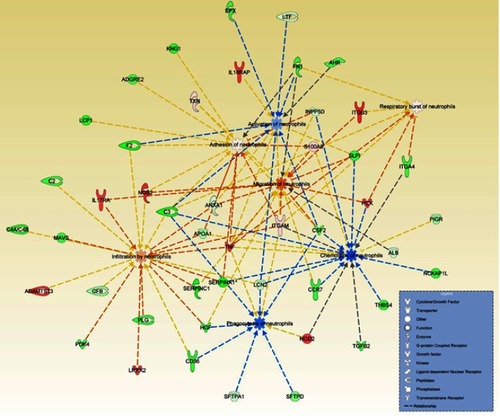Figures & data
Table 1 Definitions of neutrophil terms employed for biocuration
Figure 1 Cumulative effect of bronchoalveolar lavage fluid (BALF) proteins on neutrophil functions in asthmatic vs control horses. A total of 1,003 proteins were reviewed to identify their effects on ten neutrophil functions. Peer-reviewed manuscripts were read and actions involving ten neutrophil functions were scored for each protein as pro (+1), anti (−1), no effect (0), or no data. The contribution of each protein to each neutrophil function was calculated as the product of magnitude of expression multiplied by its effect (ie, −1, 0, +1), then these values were tabulated for category of neutrophil function. Bars represent the predicted net effect of BALF proteins on the respective neutrophil function.

Figure 2 Ingenuity® Pathway Analysis (IPA) predicted decreases in three and increases in four neutrophil functions. An interactive network was derived using IPA by screening 1,003 proteins in bronchoalveolar lavage fluid (BALF) of asthmatic vs control horses for their impact on neutrophil activity. Green shades indicate relative downregulation of proteins in asthmatic BALF (and relative upregulation in control BALF), while red shades indicate relative upregulation of proteins in asthmatic BALF (and relative downregulation of proteins in control BALF). Blue indicates predicted decreases in neutrophil functions, while orange shades indicate predicted increases. More intense (darker) colors indicate greater increases or decreases. Together, this network indicated net downregulation of neutrophil activation, chemotaxis, and phagocytosis, and upregulation of neutrophil migration, adhesion, infiltration, and respiratory burst. Broken lines indicate a relationship between the proteins and the neutrophil functions.

Table 2 Comparison of proteins curated by Ingenuity® Pathway Analysis (IPA) vs manual biocuration. Bolded proteins were common between the two methodologies
